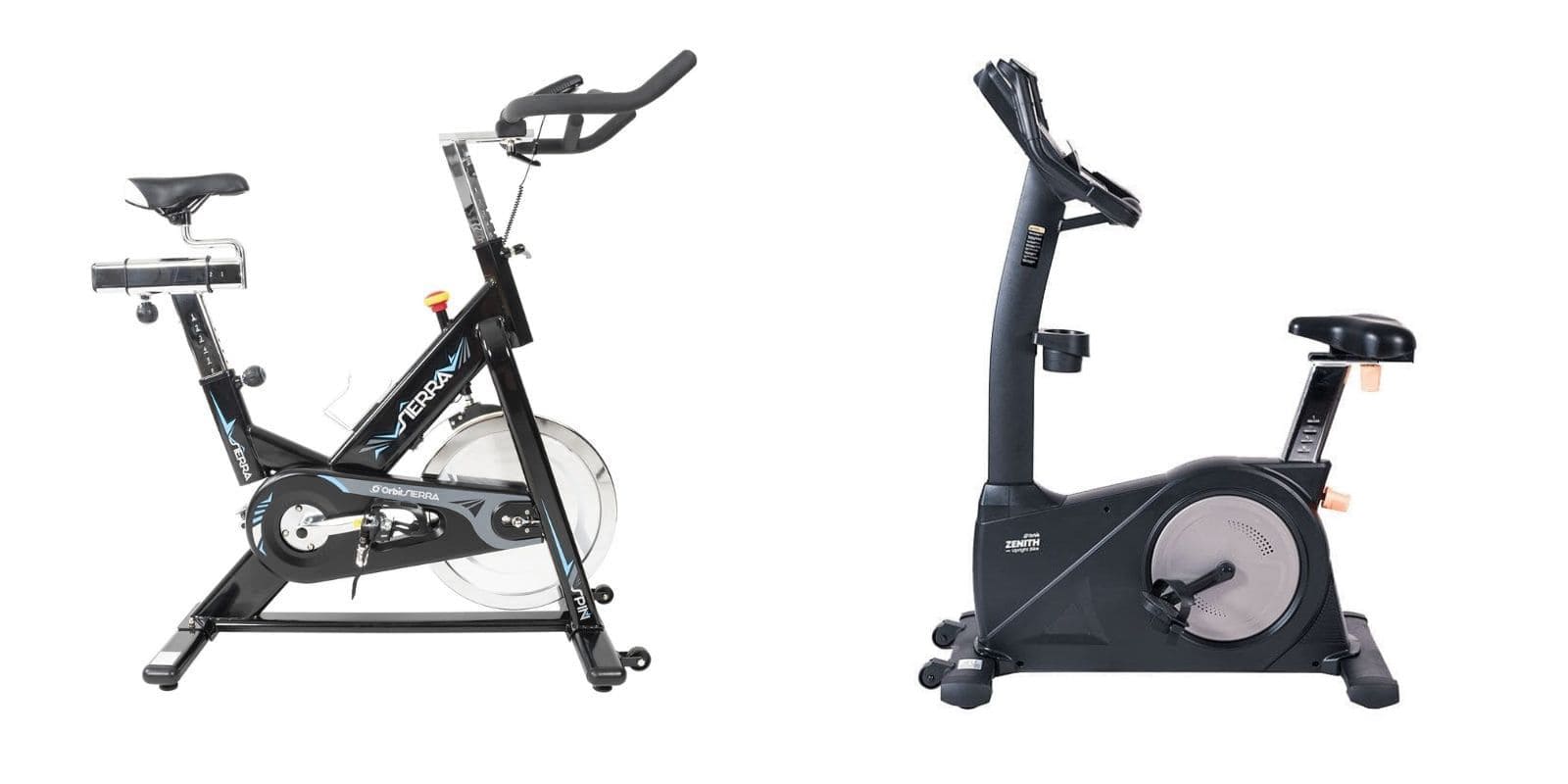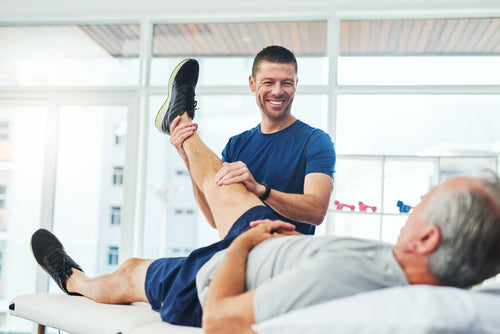
Upright Bike vs Spin Bike: 7 Crucial Differences (And Which One Is Right for You)
Buying an exercise bike? You’ll quickly discover two main types — upright and spin bikes. They may look alike, but they ride very differently, and choosing the wrong one can mean discomfort, wasted money, or stalled progress.
This guide reveals the 7 key differences so you’ll know exactly which bike suits your body, fitness level, and goals — whether you’re rehabbing after injury, staying active with the NDIS, training hard, or simply cycling at home.

What’s the Real Difference Between an Upright Bike and a Spin Bike?
While upright and spin bikes may look similar at first glance, they’re built for very different experiences — and choosing the right one can make or break your fitness or rehab routine.
Upright Bike
-
Vertical, natural posture with chest-level handlebars and pedals under hips.
-
Wide, cushioned saddle for longer, comfortable sessions.
-
Low-impact cardio ideal for rehab, seniors, and general fitness.
-
Often includes digital consoles, pre-set workouts, and magnetic resistance for smooth, quiet pedalling.
Spin Bike
-
Forward-leaning posture, narrow saddle, heavy flywheel for road-bike feel.
-
Built for speed, power, and high-intensity intervals.
-
Allows standing climbs and sprints for full-body engagement.
-
More strain on back, wrists, and knees if form is poor.
So, the real difference is this:
➡️ Upright bikes are built for comfort and controlled cardio.
➡️ Spin bikes are built for power, intensity, and athletic training.
Both have value — but knowing which suits your mobility, strength, and goals is key.
Upright Bike vs Spin Bike Comparison: The 7 Must-Know Differences
1. Seating and Posture – Comfort vs Performance
-
Upright Bikes keep you in a near-vertical position, reducing load on the lumbar spine and minimising wrist and shoulder strain — a posture recommended by the American College of Sports Medicine for older adults and rehab clients (ACSM).
-
The Arthritis Foundation confirms upright cycling can maintain joint mobility without overloading cartilage, making it safer for those with arthritis.
-
Spin Bikes mimic the aggressive forward lean of a road bike, engaging the core and upper body more actively.
-
While this improves athletic performance, it can exacerbate lower back or wrist discomfort if used without correct form.

Side by side comparison of the more upright and relaxed body position on the upright bike vs the forward lean and more aggressive stance on the spin bike.
2. Flywheel and Resistance – Momentum vs Control
- Upright bikes often use lighter flywheels with magnetic resistance, allowing for smoother pedalling and precise load control.
- Magnetic systems also allow instant stopping — a safety advantage in clinical settings where sudden halts may be required (British Journal of Sports Medicine).
-
Spin bikes typically feature heavier flywheels and fixed-drive systems that build cycling-specific momentum.
-
This creates a more realistic road feel but makes it harder to stop abruptly, increasing fall or strain risk for less stable riders.
3. Workout Style – HIIT Drill vs Steady Pace
-
Spin Bikes excel at high-intensity interval training, enabling rapid resistance changes for sprints and climbs.
-
This style of training is proven to improve cardiovascular fitness and VO₂ max in less time (Journal of Sports Sciences).
-
Upright Bikes are better suited for steady-state cardio, endurance building, and active recovery.
-
Their consistent resistance and comfort make them ideal for daily use in rehab and senior fitness programs.
4. Comfort and Adjustability – Ease of Use vs Fit Tuning
-
Upright Bikes prioritise comfort with wide, cushioned saddles, step-through frames, and minimal adjustments.
-
These features make them accessible to people with mobility limitations, a key factor in adherence to rehab programs (Clinical Rehabilitation Journal).
-
Spin bikes offer four-way adjustability for seat and handlebars, allowing precise ergonomic setup.
-
While great for performance alignment, it can be overwhelming for beginners without fitting guidance.
5. Rehab and Clinical Suitability – Safety, Control, and Gradual Progress
-
Upright Bikes are widely prescribed in early rehabilitation for joint replacements or soft-tissue injuries.
-
Gentle cycling promotes blood flow, reduces stiffness, and maintains range of motion without high impact (Journal of Orthopaedic & Sports Physical Therapy).
-
Spin Bikes are better reserved for later-stage rehab or athletic conditioning.
-
The higher loads and fixed-gear design demand stronger balance, joint control, and cardiovascular capacity.
-
However to maximise safety and recovery while minimising risk of future injury (such as falling, significant joint impact, or just high uncomfortability) recumbent bikes are the best choice due to their reclined comfortable seat, very low risk of falling and minimal joint impact.

Photograph showing the athletic and high intensity nature of spin bikes, different from upright bikes which are for a more moderate intensity of riding.
6. Space and Noise – Quiet Footprint vs Gym Vibe
-
Upright Bikes are typically lighter, smaller, and extremely quiet when magnetic resistance is used.
-
This makes them suitable for shared spaces, small clinics, and home environments.
-
Spin Bikes are heavier and more robust, designed to handle intense, out-of-saddle riding.
-
Friction-resistance models produce a faint rubbing sound, while magnetic spin bikes offer near-silent operation.
7. Price and Maintenance – Low Hassle vs Heavy-Duty Performance
-
Upright bikes often include consoles, pre-programmed workouts, and magnetic resistance at a lower cost.
-
Maintenance is minimal — mainly tightening bolts and keeping the unit clean.
- Spin bikes are mechanically simple but require brake pad replacement (friction models) or occasional drive maintenance.
- Their durability makes them a strong investment for high-frequency, high-intensity training.
Upright Bike vs Spin Bike: Quick Comparison

Who Should Choose a Spin Bike?
A spin bike is the best choice if you’re looking for performance, intensity, and versatility in your workouts.
-
Athletes & Cyclists – Spin bikes closely mimic the feel of outdoor cycling, making them perfect for training indoors during bad weather or the off-season. The forward-leaning posture, heavier flywheel, and fixed drive system replicate road bike momentum and resistance.
-
HIIT Lovers – The quick resistance changes and ability to stand up in the pedals make spin bikes ideal for high-intensity interval training. You can transition from sprints to climbs in seconds, pushing your cardiovascular system and muscles to the max.
-
Group Fitness Fans – If you thrive on the energy of spin classes or virtual cycling platforms, a spin bike will give you that same immersive, sweat-drenching experience at home.
-
Advanced Fitness Users – People who are already comfortable with higher workloads and want a challenging, engaging session will appreciate the performance capabilities of a spin bike.
Key takeaway: Choose a spin bike if you want to train hard, ride like a road cyclist, and push your limits.
Who Should Choose an Upright Bike?
An upright bike is the best option for comfort, accessibility, and controlled low-impact exercise.
-
Rehab Clients – Physiotherapists frequently prescribe upright biking to help restore range of motion, improve circulation, and rebuild strength without high joint stress.
-
Seniors – The stable, upright seating position and easy mounting make it ideal for older adults who want safe cardiovascular exercise to maintain mobility and balance.
-
Beginners – Upright bikes are less intimidating, more comfortable to sit on for extended periods, and easy to adjust for a wide range of fitness levels.
-
NDIS Participants – For those managing disabilities or recovering from injury, upright bikes provide a safe, supportive way to exercise at home, often qualifying for NDIS funding.
-
Home Users Seeking Comfort – If you want a quiet, easy-to-use bike you can hop on daily, the upright bike offers a straightforward, no-fuss experience.
Key takeaway: Choose an upright bike if you need comfort, safety, and an approachable way to stay active.

Quick Decision Guide (60-Second Choice)
H2: Quick Decision Guide — Which Bike Fits You Best?
Answer these questions — your choice will be clear by the end:
-
Is comfort your top priority?
✅ Yes → Upright Bike
❌ No → Spin Bike -
Do you need low-impact rehab or senior-friendly exercise?
✅ Yes → Upright Bike (or Recumbent for extra back support)
❌ No → Spin Bike -
Do you want intense workouts with standing climbs & sprints?
✅ Yes → Spin Bike
❌ No → Upright Bike -
Do you have balance issues or joint pain?
✅ Yes → Upright Bike
❌ No → Either (based on goals) -
Do you enjoy cycling classes or HIIT training?
✅ Yes → Spin Bike
❌ No → Upright Bike
Key takeaway: Choose upright for comfort, safety, and rehab. Choose spin for performance, power, and cycling-specific training.
FAQs About Upright and Spin Bikes
Which burns more calories: a spin bike or upright bike?
A spin bike can burn more calories in the same time because it supports higher-intensity intervals and standing climbs, but calorie burn ultimately depends on effort.
Which is safer for bad knees?
An upright bike is generally safer due to lower joint impact and the ability to stop pedalling instantly. Spin bikes have more momentum from the flywheel, which can strain knees if form or resistance is incorrect.
Can I use a spin bike for rehab?
Only in later stages of recovery and under professional guidance. For early rehab or mobility issues, an upright bike is usually the better choice.
Are upright bikes easier to use than spin bikes?
Yes. Upright bikes have a more natural seating position and fewer adjustments, making them more beginner-friendly.
Which bike is quieter?
Upright bikes are almost silent thanks to magnetic resistance. Magnetic spin bikes are also quiet, but friction-resistance spin bikes can make a gentle rubbing sound.
Do I need special shoes for a spin bike?
Not necessarily—many spin bikes work with standard gym shoes, but using cycling shoes with cleats can improve pedalling efficiency.
Which lasts longer?
Both can last for many years with proper care. Upright bikes often have less wear and tear due to their lower-intensity use, while spin bikes are built to handle vigorous training.

Need Help Choosing the Right Bike?
At Prime Physio Essentials, we understand that choosing between an upright and spin bike can feel overwhelming - especially if you’re buying for rehab, an NDIS plan, or a mixed-use clinic. That’s why we offer free personalised advice to match you with the safest, most effective bike for your needs.
-
✅ NDIS Quotes & Invoicing – We help you get your bike funded where eligible. You can get personalised assistance with all NDIS related services for our exercise bike range through the form on our NDIS page.
-
✅ Rehab-Focused Recommendations – Based on physiotherapy best practice.
-
✅ Home & Clinic Solutions – From comfort-focused models to high-performance training bikes.
Contact us today for expert guidance, or browse our exercise bike range to find your perfect fit.


Leave a comment